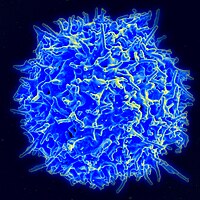
Photo from wikipedia
Abstract Background Human T-cell lymphotropic virus (HTLV-1) is a retrovirus endemic in Latin America, Africa, and Asia. Increasing numbers are being reported in the United States. HTLV-1 causes Adult T-cell… Click to show full abstract
Abstract Background Human T-cell lymphotropic virus (HTLV-1) is a retrovirus endemic in Latin America, Africa, and Asia. Increasing numbers are being reported in the United States. HTLV-1 causes Adult T-cell Leukemia/Lymphoma (ATL) in 3–5% of HTLV-1 carriers, usually only after a prolonged latent period. Co-infection with the nematode Strongyloides stercoralis (SS) is associated with early onset of ATL. The exact mechanism by which SS accelerates ATL development in HTLV-1 subjects is not understood. CADM1 has been recently identified as a surface marker of HTLV-1 infected cells; CD7 is a probable marker of early cell transformation. We hypothesize that previous SS infection will increase the proportion of infected T cells (CADM1+) and lead to transformation of infected cells (CADM1+CD7low) in HTLV-1 subjects. Methods In this pilot study, we tested seven subjects that were diagnosed with HTLV-1 between 2006 and 2008 and actively followed up at the HTLV-1 Cohort Clinic at the Tropical Medicine Institute in Lima, Peru. Five had previous SS infection. We performed surface flow cytometry staining of peripheral blood mononuclear cells with monoclonal antibodies against CADM1, CD7, CD4, and CD3. Current SS infection was ruled out by the Baermann technique in a stool sample. Results Average age was 53 years (range 30–79). Average time since diagnosis of HTLV-1 was 10 years (range 9–11). One 30-year-old patient with prior SS infection was diagnosed with ATL and hospitalized in the ICU at the time of follow-up and excluded from group comparison. There was a trend for higher proportions of CADM1+ T-cells in subjects with previous SS co-infection compared with those without SS (median 16.20% vs. 9.55%, P = 0.13, Mann–Whitney). The proportion of PBMCs that were CADM1+CD7− was also increased in some of those with previous SS (Figure 1). Conclusion Our pilot data suggest that SS co-infection is associated with prolonged effects on HTLV-1 infection. We noted trends towards increased numbers of HTLV-1 infected cells (CADM1+) and a predisposition towards malignant transformation (CADM1+CD7low). Further studies are needed to confirm this observation and to determine whether CADM1 and CD7 expression may be useful as a screening tool to monitor HTLV-1 subjects at high risk of developing ATL.Figure 1. Representative flow cytometry. Disclosures All authors: No reported disclosures.
Journal Title: Open Forum Infectious Diseases
Year Published: 2017
Link to full text (if available)
Share on Social Media: Sign Up to like & get
recommendations!